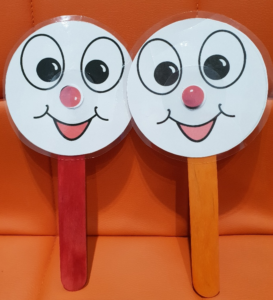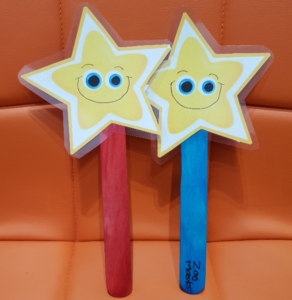Puppet greetings
 Growing up with puppets is fun, fun, fun. Puppets know how to say hi and goodbye. In fact puppets have perfect communication manners all the time!Have you ever wondered how children know what to say? When my grandson, aged 4, eye-balled his new Kindy teacher and said, "Hello, Miss Mariano, my name is Hunter. How are you going today?" my daughter and I looked at one another with a little smirk, wondering what Miss M would think of her new outgoing, verbally competent charge. Graciously, she bent down, shook his hand and replied, "Very well thank you Hunter, and you?"Maybe children learn, like we all may have, to socialise according to our local custom. If your family says "G'day, mate" when greeting one another, maybe your children will too. If your family says "Hi, great to see you!" with a burst of expression it is most likely that your children will do the same. But what if your child might not be able to understand, copy or replicate your family's greeting method? What if her speach was a little delayed? What if, for any reason, she misses social cues in general. Or what if she gets all the social cues, but it takes longer than usual for her to respond to them using the "normal", socially accepted and expected manner? By the time she has heard the greeting, worked out what it means, worked out how she should respond, and then made her response, the moment is well and truly over. The person who was greeting her has lost interest in the greeting and moved on. Along with the moment, the learning opportunity is also gone.Puppets play a vital role in sharing communication skills with children who might otherwise not pick up on these skills in normal day to day living. Puppets can say a lot of things many times in the day. Some youngsters may need to hear things more often than others. Puppets can set the perfect example over and over again. You don't have to wait to meet a friend, family member or stranger to teach your younger children good communication manners or even simple greetings.
Growing up with puppets is fun, fun, fun. Puppets know how to say hi and goodbye. In fact puppets have perfect communication manners all the time!Have you ever wondered how children know what to say? When my grandson, aged 4, eye-balled his new Kindy teacher and said, "Hello, Miss Mariano, my name is Hunter. How are you going today?" my daughter and I looked at one another with a little smirk, wondering what Miss M would think of her new outgoing, verbally competent charge. Graciously, she bent down, shook his hand and replied, "Very well thank you Hunter, and you?"Maybe children learn, like we all may have, to socialise according to our local custom. If your family says "G'day, mate" when greeting one another, maybe your children will too. If your family says "Hi, great to see you!" with a burst of expression it is most likely that your children will do the same. But what if your child might not be able to understand, copy or replicate your family's greeting method? What if her speach was a little delayed? What if, for any reason, she misses social cues in general. Or what if she gets all the social cues, but it takes longer than usual for her to respond to them using the "normal", socially accepted and expected manner? By the time she has heard the greeting, worked out what it means, worked out how she should respond, and then made her response, the moment is well and truly over. The person who was greeting her has lost interest in the greeting and moved on. Along with the moment, the learning opportunity is also gone.Puppets play a vital role in sharing communication skills with children who might otherwise not pick up on these skills in normal day to day living. Puppets can say a lot of things many times in the day. Some youngsters may need to hear things more often than others. Puppets can set the perfect example over and over again. You don't have to wait to meet a friend, family member or stranger to teach your younger children good communication manners or even simple greetings. A very simple way of introducing puppets into the home is to make a stick figure face. More complex material puppets that look like a donkey, a cow or a duck are not needed just yet. A long, thick pop stick for a neck and a round, happy, smiley face with big, attractive eyes is all you need for a couple of speaking friends.Your child may like to help you make the puppets. I make two puppets so that they can chat to one another. The faces and stars are cut out and then laminated. Other suggestions are Sunface Puppets and a variety of Animal face puppets.
A very simple way of introducing puppets into the home is to make a stick figure face. More complex material puppets that look like a donkey, a cow or a duck are not needed just yet. A long, thick pop stick for a neck and a round, happy, smiley face with big, attractive eyes is all you need for a couple of speaking friends.Your child may like to help you make the puppets. I make two puppets so that they can chat to one another. The faces and stars are cut out and then laminated. Other suggestions are Sunface Puppets and a variety of Animal face puppets.